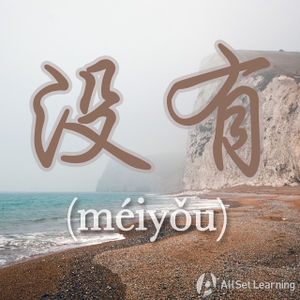Difference between revisions of "Expressing comparable degree with "you""
| Line 3: | Line 3: | ||
有 (yǒu), besides just meaning "to have," can also be used in comparisons. It's what you use instead of 比 (bǐ) if something is "as [Adj.] as" something else. | 有 (yǒu), besides just meaning "to have," can also be used in comparisons. It's what you use instead of 比 (bǐ) if something is "as [Adj.] as" something else. | ||
| − | == | + | == Basic Pattern == |
| − | The structure is very straightforward. It literally means "A has B's [Adj.]." The meaning is "A is as [Adj.] as B." This pattern is often used in questions. | + | The structure is very straightforward. It literally means "A has B's [Adj.]." The meaning is "A is as [Adj.] as B." This pattern is often used in questions. 注意B往往是被肯定的一方。 |
=== Structure === | === Structure === | ||
| Line 13: | Line 13: | ||
</div> | </div> | ||
| − | + | or | |
<div class="jiegou"> | <div class="jiegou"> | ||
| − | A + 有 | + | A + 有 + Verb + 得 + Adj. + 吗 ? |
</div> | </div> | ||
| Line 24: | Line 24: | ||
*他 <em>有</em> 我 帅 吗 ?<span class="pinyin">Tā <em>yǒu</em> wǒ shuài ma?</span><span class="trans">Is he as handsome as me?</span> | *他 <em>有</em> 我 帅 吗 ?<span class="pinyin">Tā <em>yǒu</em> wǒ shuài ma?</span><span class="trans">Is he as handsome as me?</span> | ||
| − | * | + | *你 的 压力 <em>有</em> 我 大 吗 ?<span class="trans">Is your pressure as much as mine?</span> |
| − | *你 | + | *你 <em>有</em> 老板 忙 吗 ?<span class="trans">Are you as busy as the boss?</span> |
| − | * | + | *你 <em>有</em> 他 说 <strong>得</strong> 好 吗 ?<span class="trans">Can you speak as well as he does?</span> |
| − | *他 <em>有</em> | + | *他 <em>有</em> 老师 懂 <strong>得</strong> 多 吗 ?<span class="trans">Does he know even more about the teacher?</span> |
</div> | </div> | ||
| − | == | + | == Advanced Pattern == |
| − | + | This form is often used with 那么, which in this case means "as much." And it indicates that B is already very [Adj.]. When B is absent, 那么 mean "so" or "that". | |
| − | |||
| − | |||
| − | |||
<div class="jiegou"> | <div class="jiegou"> | ||
| − | + | A + 有 (+ B) + 那么 + Adj. + 吗 ? | |
</div> | </div> | ||
| + | |||
| + | |||
=== Examples === | === Examples === | ||
<div class="liju"> | <div class="liju"> | ||
| − | |||
| − | |||
| − | |||
| − | < | + | *她 <em>有</em> <strong>那么</strong> 漂亮 吗 ?<span class="pinyin">Tā <em>yǒu</em> <strong>nàme</strong> piàoliang ma?</span><span class="trans">Is she that pretty? Really?</span> |
| − | * | + | *你 <em>有</em> 他 <strong>那么</strong> 吗 ?<span class="pinyin">Tā <em>yǒu</em> <strong>nàme</strong> piàoliang ma?</span><span class="trans">Is she that pretty? Really?</span> |
| − | *他 <em>有</em> | + | |
| − | + | *他 <em>有</em> 姚明 <strong>那么</strong> 高 吗 ?<span class="pinyin">Tā <em>yǒu</em> YáoMíng <strong>nàme</strong> gāo ma?</span><span class="trans">Is he as tall as YaoMing?</span> | |
| − | |||
| − | |||
| − | |||
| − | |||
| − | |||
| − | |||
| − | |||
</div> | </div> | ||
Revision as of 07:55, 21 December 2017
-
Level
-
Similar to
-
Used for
-
Keywords
有 (yǒu), besides just meaning "to have," can also be used in comparisons. It's what you use instead of 比 (bǐ) if something is "as [Adj.] as" something else.
Contents
Basic Pattern
The structure is very straightforward. It literally means "A has B's [Adj.]." The meaning is "A is as [Adj.] as B." This pattern is often used in questions. 注意B往往是被肯定的一方。
Structure
A + 有 + B + Adj. + 吗 ?
or
A + 有 + Verb + 得 + Adj. + 吗 ?
Examples
- 他 有 我 帅 吗 ?Is he as handsome as me?
- 你 的 压力 有 我 大 吗 ?Is your pressure as much as mine?
- 你 有 老板 忙 吗 ?Are you as busy as the boss?
- 你 有 他 说 得 好 吗 ?Can you speak as well as he does?
- 他 有 老师 懂 得 多 吗 ?Does he know even more about the teacher?
Advanced Pattern
This form is often used with 那么, which in this case means "as much." And it indicates that B is already very [Adj.]. When B is absent, 那么 mean "so" or "that".
A + 有 (+ B) + 那么 + Adj. + 吗 ?
Examples
- 她 有 那么 漂亮 吗 ?Is she that pretty? Really?
- 你 有 他 那么 吗 ?Is she that pretty? Really?
- 他 有 姚明 那么 高 吗 ?Is he as tall as YaoMing?
See also
- Basic comparisons with "meiyou"
- Basic comparisons with "bi"
- Basic comparisons with "bu bi"
- Comparisons with "buru"
- Basic comparisons with "yiyang"
Sources and further reading
Books
- New Practical Chinese Reader 3 (新实用汉语课本3) (pp. 33-4) Anything Goes (无所不谈) →buy
- 现代汉语八百词 (pp. 631) 卓越汉语-公司实战篇 →buy



